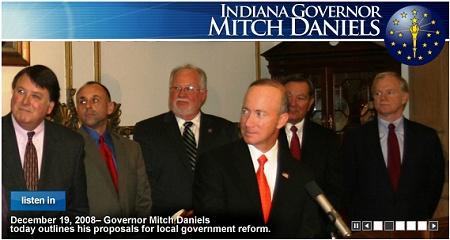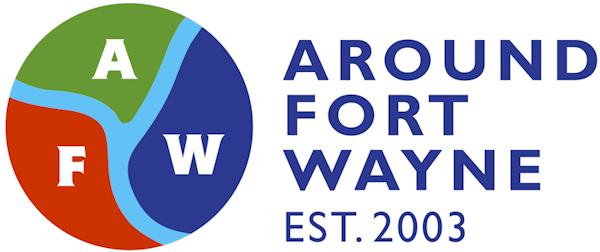
On December 19, 2008, Indiana Governor Mitch Daniels announced his local government reform initiatives.  This stems from his Indiana Commission on Local Government Reform which including Indiana Supreme Court Justice Randall Shepard and former Indiana Governor Joe Kernan, to name a few.  Here is the press release from the event:
Daniels announces 2009 initiatives for reforming local government
INDIANAPOLIS (December 19, 2008) – Governor Mitch Daniels today outlined his proposals for local government reform to be considered by the Indiana General Assembly in 2009. Members of the Indiana Commission on Local Government Reform, including Indiana Supreme Court Justice Randall Shepard, co-chair, of the commission, joined the governor for the announcement.
“This is a set of changes that are long overdue in Indiana. We are an outlier among the states. We have more of almost everything – taxing units, subdivisions and politicians – than elsewhere. More than we need, more than taxpayers can get good service for, and certainly more than we should be paying for,” said Daniels.
The governor recommended that a majority of the 27 recommendations from the Commission report move forward. Among the most significant, Daniels said there should be one county executive, a stronger legislative body for county government, elimination of townships, and reorganization of school district central office operations.
The governor’s recommendations below are organized according to the order of the proposals in the 2007 report issued by the Commission, co-chaired by Shepard and former Governor Joe Kernan, who was unable to attend the announcement because of inclement weather in northern Indiana. The Commission’s recommendation is italicized, followed by the governor’s recommendation, then a brief rationale. If the recommendation includes a change to the Commission’s original recommendation, the change is also described. Several recommendations have already been implemented and are so noted.
1. Establish a single-person elected county executive. – Recommended
Rationale: We do not elect three presidents or three mayors, and no business would hire three CEOs to direct its activities, yet Indiana’s three-member county commissions are hamstrung by just such a structure. A single elected county executive would provide county government with a single point of leadership, contact and accountability. Even the Indiana Association of County Commissioners concedes the ‘buck’ never really stops in county government. It’s time for that to change.
2. Establish a single, unified legislative body for county government. Expand legislative membership to ensure sufficient representation for included rural, suburban and urban populations. – Recommended
Rationale: Indiana is the only state that divides fiscal and other legislative decision making between its county commissions and councils. The council approves the county budget but the commission approves all other legislation. This is a recipe for confusion and passing the buck. The county council should serve as the county legislature, providing appropriate checks and balances on the single elected county executive and broad representation.
3. Transfer the responsibility for administering the duties of the county auditor, treasurer, recorder, assessor, surveyor, sheriff and coroner to the county executive. Transfer the varied duties of the clerk of the courts to the county election board and the county executive. Establish objective minimum professional qualifications and standards for certain county administrative functions. – Recommended with changes
Changes: The sheriff, clerk and auditor would remain elected. The county assessor, county treasurer, county recorder, county surveyor and county coroner would be appointed by the county executive. The elected county auditor would retain the duties associated with handling and distributing funds to units of government in the county.
Rationale: The sheriff, clerk and auditor should remain elected offices. As the chief county law enforcement official, the sheriff should remain accountable to voters. Similarly, because the clerk plays a crucial role in elections, that position should also answer directly to voters. The auditor should remain elected because this officer handles state and federal money on behalf of all the local government units in the county. All of the auditor’s property tax billing duties, however, should be transferred to the county executive.
The duties of the other county officers are mainly administrative and could best be performed by appointed professionals, creating better accountability. For example, under the current structure, three separately elected officials (assessor, auditor, treasurer) each have significant roles to play in the property tax billing process-but none of them can require the other to carry out their responsibilities. This dispersion of responsibility frequently contributes to delayed property tax billing which results in cities, counties and schools paying millions in borrowing costs.
Only 16 states make provision for electing county officers in their constitution, and none of those elect more than Indiana. It makes little sense to put so many of these offices in Indiana’s Constitution today, and even less when they are mostly administrative in nature.
4. Retain a local government role for property tax assessment under a county assessor who is required to meet professional qualifications and appointed by the county executive. – Partially Completed and Recommended
Rationale: 2008’s House Enrolled Act 1001, the governor’s property tax plan, transferred the duties of most township assessors to the county level. In the November general election, voters in 30 of the remaining 43 townships voted to eliminate their township assessors. Although the state has already made significant progress on this recommendation, allowing the county executive to appoint the county assessor would complete the goal of fully enacting this recommendation.
5. Create a countywide body to oversee the provision of all public safety services. – Recommended
Rationale: There are currently more than 1,150 local government police and fire departments providing public safety services across the state. This results in a costly, complex and duplicative system that has the potential to affect citizen access to critical services when minutes matter. While the state has provided ways for local governments to collaborate on fire protection, less than 80 of these arrangements have been made in the past 27 years. It is time to require a countywide planning process to ensure that every citizen has access to the best public safety services available and that resources are used in the best way to provide those services.
6. Consolidate emergency public safety dispatch by county or multi-county region. Require that new, local emergency communications systems be compatible with the Project Hoosier SAFE-T statewide 800 MHz communications system. – Done
How accomplished: HEA 1204 requires each county to have no more than two public safety answering points (PSAPs) by January 1, 2015. This will provide consolidated, effective and efficient public safety dispatch in each county.
7. Transfer the responsibility for all funding of the state’s trial court system to the state including public defenders and probation. – Recommended with changes
Rationale: Once the state’s fiscal circumstances improve, it would make sense for the state to assume the costs of the trial court system over a period of years, including probation officers and public defenders. Indiana’s courts could operate more efficiently and fairly, ensuring that all citizens have the same access to justice. A transition period would be necessary to allow time for currently serving judges to complete their terms in office.
8. Move the funding of child welfare from counties to the state. – Done
How accomplished: HEA 1001 provides that in 2009 the state will begin paying the full costs of child welfare, expenses formerly paid for almost exclusively by property taxes.
9. Transfer the responsibility for administering the duties of township government for assessment, poor relief, fire protection, emergency medical services, cemeteries and any other remaining responsibilities to the county executive. Establish a countywide poor relief levy. – Recommended
Rationale: Township government is an outdated legacy of the 19th century. Today, 31 states operate without township government and only eight have more than Indiana’s 1,008. Many townships are just too small, in terms of area, assessed value and population, to provide cost-effective public services. Many townships spend more on administrative expenses than they do on critical services such as poor relief. For example, the aggregate administrative cost in one county was $1.33 for every dollar of direct assistance. The legislation should create a county poor relief transition planning body with broad bipartisan representation, including elected township and county officials, human services providers, and others to ensure a smooth transition to a countywide system.
Local fire departments, volunteer and full-time, would continue and would report to the county executive rather than township trustees. Resource decisions would be made at the county level based on recommendations from the public safety boards that would be created by recommendation #5.
Transferring township duties to the county would allow for more efficient planning, provide a broader tax base for funding, and reduce the overall complexity of Indiana’s current system of local government.
10. Transfer the responsibilities of the township small claims courts in Marion County to superior courts. – Recommended
Rationale: The only remaining township small claims courts are located in Marion County. These courts, judges and constables, should be integrated into the Marion Superior Court, with provision for court locations dispersed through the county.
11. Reorganize school districts to achieve a minimum student population of 2,000. Establish state standards and a county-based planning process similar to that established in 1959 legislation. – Recommended with changes
Changes: School districts with less than 1,000 students should combine their district central office operations with another school district unless they are already a countywide district. After central office reorganization, no high schools may be closed for the next five years.
Rationale: This proposal is solely aimed at reducing the number of school corporations in Indiana, not the number of schools in our state. Education experts agree that school districts of less than 1,000 students are not able to provide the educational opportunities necessary for student success in the 21st Century. In Indiana, small corporations offer far fewer advanced placement courses, foreign languages and advanced math/science courses than corporations with more than 1,000 students.
12. Require that school corporation bonds be approved by the fiscal body of the municipal or county government containing the greatest proportion of assessed value in the school district. – Not recommended
Rationale: HEA 1001 required a public referendum before schools could move forward with major capital projects. This provides the necessary oversight for school projects.
13. Prompt joint purchasing by schools. – Recommended
Rationale: Indiana schools participate in shared purchasing and services arrangements but there is more to be done to capitalize on economies of scale. Additional savings opportunities exist.
14. Conduct all non-partisan school elections during November in even years. – Recommended
Rationale: School districts currently have the option to hold non-partisan elections during primary or general elections. Since primary election turnouts are generally low, holding school elections in November in even years would enhance voter participation.
15. Allow the city council to appoint the city clerk in second-class cities. – Recommended with changes
Changes: Also allow the mayor to appoint the clerk-treasurer in third-class cities.
Rationale: As previously recommended, administrative positions should be appointed. The clerk is the secretary to the city council. The clerk-treasurer in third-class cities provides a similar function as the appointed controller in second-class cities. Clerk-treasurers in towns would remain an elected position.
16. Move all municipal elections to an even-year cycle. – Recommended
Rationale: Unlike other Indiana elections which are held in even years, municipal elections are held in odd years, so there is extra cost. Moving municipal elections to even years would save costs and enhance voter participation.
17. Transfer the responsibilities of municipal health departments to the county health department. – Recommended
Rationale: Municipal health departments only exist in Lake County. Hammond recently dissolved its municipal health department and is now covered by the county. East Chicago and Gary are the only remaining communities where taxpayers pay for two departments and receive the service of one.
18. Reorganize library systems by county and provide permanent library service for all citizens. – Recommended
Rationale: A single, countywide library district would enhance access to libraries and save taxpayer dollars. Indiana has 238 library districts serving communities with populations of 250 to 833,000. Some 400,000 Hoosiers in 38 counties do not have access to library services in their communities. These disparities have been recognized by the Indiana Public Library Coalition, which has recommended legislation to mandate a countywide planning process to provide universal service and meet statewide standards. Fifty-seven percent of all library districts serve populations of less than 10,000. One library district spends more than $73 in administrative costs for each book circulated. A single countywide library district overseen by a county library board would achieve better balance between cost and service.
19. Require that the budgets and bonds of library and all other special districts be approved by the fiscal body of the municipal or county government containing the greatest proportion of assessed value in the unit seeking approval. – Done
How accomplished: HEA 1001 required that budgets and capital projects of local governments with appointed boards be approved by the fiscal body of the county or city government, depending on where the majority of the unit’s assessed value is located.
20. Strengthen the current joint purchasing infrastructure for libraries. – Can be accomplished through administrative action. No legislation needed.
Rationale: The governor’s OneIndiana joint purchasing plan provides purchasing options for libraries by allowing them to purchase from the state’s Quantity Purchasing Agreements (QPAs). This recommendation could also be achieved through the use of inter-local agreements.
21. Expand voluntary coordination and consolidation of units and services. Strengthen the power of voters to compel consolidation. – Recommended
Rationale: In 2006, the governor signed the Government Modernization Act (HEA 1362), which gave local governments the power to voluntarily consolidate. The existing statute is complicated and underutilized. Since then, only one successful consolidation (Zionsville plus two townships) has occurred. To enhance voluntary consolidation, voters should have more involvement in the process and affected local governments less influence.
22. Allow local governments to establish service districts with differentiated levels of service and corresponding tax rates. – Recommended
Rationale: Service districts have been used successfully in a number of consolidation efforts around the country to address the concerns of non-municipal residents about paying for levels of service that are unavailable or inappropriate. For example, a consolidated unit may establish a service district smaller than its entire boundaries to help specific residents with sewer services. Residents and businesses within the service district would pay for sewer services and those outside it would not. This would enhance the flexibility of local governments to respond to differing levels of local need and could be particularly useful in the case of public safety coordination and planning.
23. Facilitate local improvement efforts using best management and business practices. Strengthen state mechanisms that support these activities, particularly for collective purchasing. – Done through administrative action. No legislation needed.
Rationale: The Indiana Department of Administration (IDOA) currently allows local governments to purchase from over 180 state contracts; 50 are posted online for easy access. Each month, IDOA adds several new contracts to the online list.
24. Prohibit employees of a local government unit from serving as elected officials within the same local government unit. – Recommended
Rationale: Indiana allows employees of a unit of local government to serve as elected policymakers for that unit (i.e. a deputy or a county officer could serve on the county council). This is a clear conflict of interest, and should be prohibited.
25. Assign the Indiana Advisory Commission on Intergovernmental Relations (IACIR) to monitor the progress toward these recommendations and conduct additional research as needed. Produce an annual report on progress through 2011. – Recommended
Rationale: The IACIR provides an important forum for elected state and local officials and other groups to discuss state-local relations. This body is ideal to monitor the progress made on these recommendations and provide a forum for discussing crucial transition issues.
26. Establish a statewide benchmarking system to provide the public and policy-makers with current information about local government productivity and progress. – Done through administrative action. No legislation needed.
27. Designate a state office to provide technical assistance to local government. – Recommended
Rationale: Because the state prescribes most of the ground rules for local government, the state should do more to help local governments understand and apply those rules. In particular, the transition to the new local government system would present significant challenges, and state assistance would be important to avoid disruption in the provision of important public services. This state office would be created within the existing function of the Office of Management and Budget and would serve both goals.
Â
Indiana Local Government Facts
Indiana currently has about 2,730 local units of government with the authority to levy property taxes. Only nine states in the country have more.
To govern all of these units, Indiana elects almost 11,000 local officials.
Only 18 states have more school districts. Indiana school districts range in size from more than 30,000 to less than 50 students; with 54 districts have less than 1,000 pupils.
Only 13 states have more library districts than Indiana’s 238. (Benton County, with a population of 9,000, has six library districts.) At the same time, more than 400,000 Hoosiers in 38 communities do not have access to community library services.
Only 19 states have any kind of township government, and only eight have more than Indiana’s 1,008 townships.
Only 16 states require elected county officers in their constitution. Indiana puts nine in its constitution, more than any other state.
Indiana is the only state that divides county legislative authority between two separately elected bodies-the county commission and the county council.
There are more than 1,150 local government police and fire departments providing public safety services across the state.





